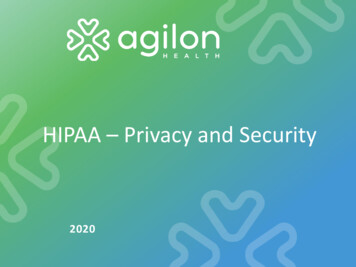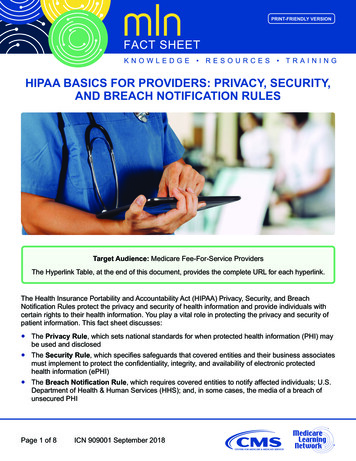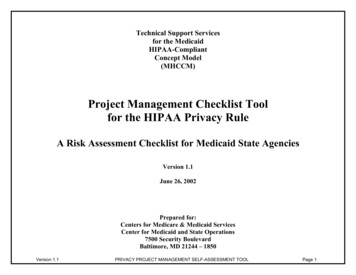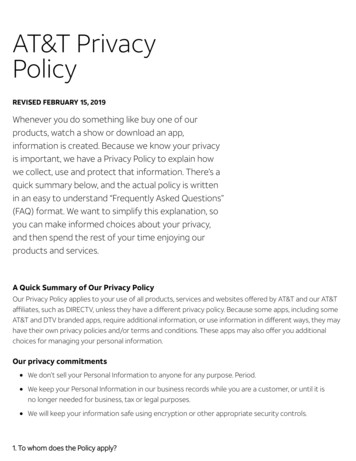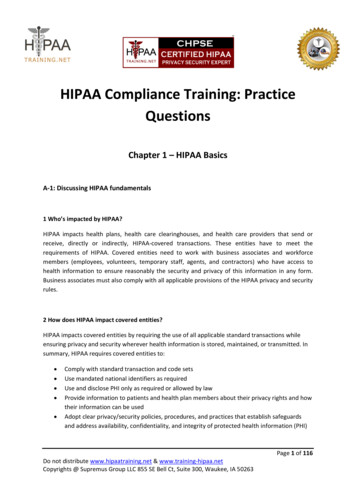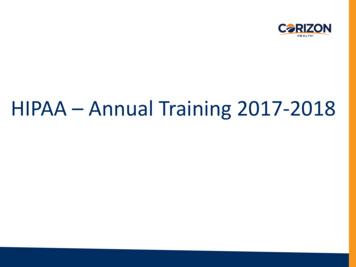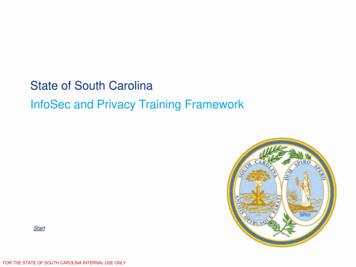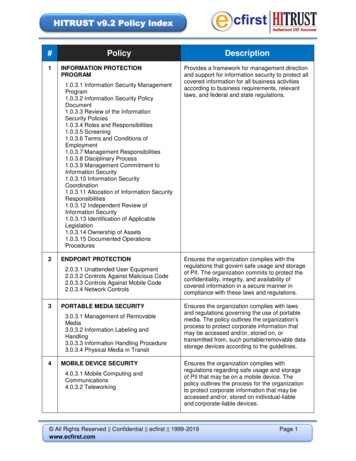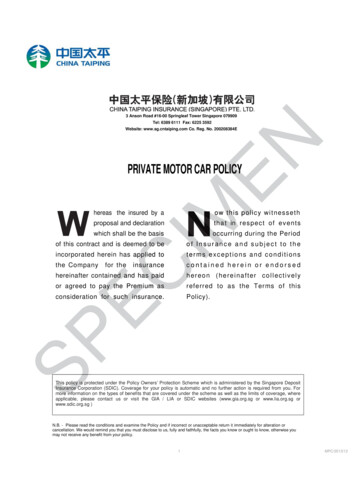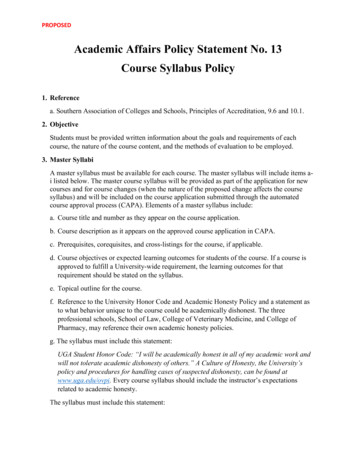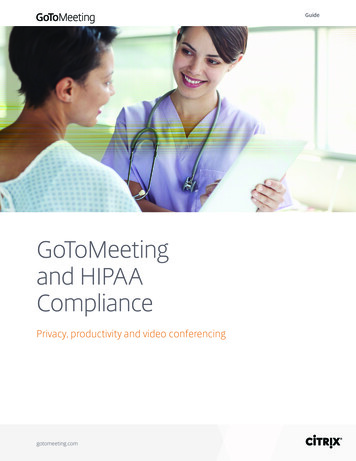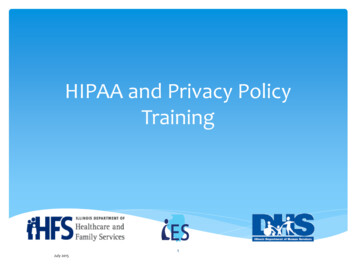
Transcription
HIPAA and Privacy PolicyTraining1July 2015
Overview of TrainingThis training addresses the requirements for maintaining the privacy ofconfidential information received from HFS and DHS (the Agencies).During this training you will learn: The definition of confidential information; The basic requirements of the laws that restrict how confidential information can beaccessed, used, and shared; Practical ways to protect the privacy and security of confidential information; and The consequences if you improperly access, use, or share confidential information.Possible sanctions include: Losing your job; Monetary fines; and Imprisonment.2
Confidential InformationConfidential Information is defined by several laws, including: HIPAA (45 CFR Parts 160, 162, and 164) Federal Medicaid Confidentiality (42 CFR 431.300-307) Personal Information Protection Act (815 ILCS 530) Identity Protection Act (5 ILCS 179) Child Support Confidentiality (45 CFR 303.21, among others) IRS Code (IRC 6103) Illinois Public Aid Code (305 ILCS 5/11-9)3
Confidential Information The General Rules1.All client information collected or received by theAgencies is CONFIDENTIAL.2.Every employee, agent, and contractor of the Agencies,and every other person or entity who receives theAgencies’ client information, must protect the privacyand security of client information.*The Agencies’ clients include applicants and beneficiaries.*4
Confidential Information The General RulesExamples of confidential information to be protected: NameAddressPhone numberDate of BirthRecipient Identification NumberSocial Security NumberDriver’s License NumberFinancial Information, including account numbers5
HIPAAThe Health Insurance Portability and Accountability Act6
HIPAA – An OverviewThe Agencies are “covered entities” under HIPAA. Thismeans that the Agencies, their employees, their agents, theircontractors, and anyone else who receives the Agencies’client information must comply with HIPAA’s rules.HIPAA provides the most basic legal protection for healthinformation. Other laws can add more protection. TheAgencies, and anyone who receives the Agencies’ data, mustcomply with all of these laws.7
HIPAA – An OverviewHIPAA requires the Agencies to safeguard their clients’Protected Health Information(PHI).8
HIPAA – PHIPHI is information that: identifies an individual (or can be used to identify anindividual); and relates to the health, payment for, or provision of healthcareto an individual.PHI can be in any form: Electronic, including email Paper Spoken9
HIPAA – PHIPHI can even include basic, non-medicalinformation. In fact, any of the following areconsidered identifiers, and are therefore PHI underHIPAA: Names Any geographic area smallerthan a state Telephone numbers Fax numbers Email addresses Age (if over 89) 10Social Security NumbersRINsDates (except year)Names of relativesAccount numbersAny other unique number thatcan be linked to an individual
HIPAAUse and Disclosure of PHIHIPAA governs: how the Agencies can access and use PHI internally; and when the Agencies can share (disclose) PHI with externalpersons or entities.The following slides provide examples of themost common acceptable uses anddisclosures of PHI.11
HIPAAAuthorized Uses and Disclosures of PHIExample 1: ConsentThe Agencies can use and disclose PHI with the written consent ofthe client.However, you must stay within the boundaries of the consent.****Common issues to look for include:- The expiration date of the consent; and- The purpose of the consent.12
HIPAAAuthorized Uses and Disclosures of PHIExample 2:Treatment, Payment, and Healthcare Operations of the Agencies (TPO)The Agencies can use and disclose PHI for their TPO activities, without obtaining aclient’s written consent.TPO includes: Accessing PHI to perform your job Determinations of eligibility Billing Care coordination activities Quality assessment and improvement activities Review of the competence and qualifications of health care professionals Review of health care services and utilization Fraud and abuse detection.13
HIPAAAuthorized Uses and Disclosures of PHIExample 3: TPO of Another Covered EntityThe Agencies can use and disclose PHI for: The treatment activities of another health care provider; The payment activities of another covered entity; and The healthcare operations of another covered entity,provided certain factors are met.Written consent from the client is not necessary for thesedisclosures.14
HIPAAAuthorized Uses and Disclosures of PHIOther Permissible SituationsHIPAA also allows disclosure of PHI in the following situations: Health oversight activities Judicial and administrative proceedings Law enforcement purposes National security Research Requests from other covered entities administering government programs orproviding public benefitsEach situation listed above must meet specific criteria before PHI can be disclosed.DO NOT DISCLOSE PHI under one of the situations listed above without writtenpermission from the Agencies.15
HIPAAAuthorized Uses and Disclosures of PHIYour entity, as a recipient of the Agencies’ client information,is permitted to access and use the information only for thepurpose for which it was shared and in compliance withHIPAA.16
HIPAAAuthorized Uses and Disclosures of PHINever disclose the Agencies’ client information to a personoutside of your organization without talking to yoursupervisor first. Your supervisor may need to contact theAgencies for permission to disclose the information.This includes requests for PHI from law enforcement or publicofficials!17
HIPAAAuthorized Uses and Disclosures of PHIMinimum NecessaryUse only the minimum amount of PHI necessary to performyour job.The “minimum necessary” standard does not apply todisclosures made to the client or his/her representative.18
HIPAA – Breach DefinedA breach under HIPAA occurs when there is an:Unauthorized access, use, or disclosure of PHI thatcompromises the security or privacy of the PHI.19
HIPAA – Breach PenaltiesYou can be held personally accountable for a violation of HIPAA.This includes:Disciplinary Action at WorkMonetary FinesImprisonmentYour actions could also subject your employer and the Agencies tomonetary penalties and negative media coverage.20
HIPAA – Breach PenaltiesPenalties for HIPAA violations include: Civil penalties: Monetary fines range from 100 to 50,000 per violation. The amount of the fine depends on (1) whether the violation is correctedwithin 30 days; and (2) whether the violation is due to willful neglect orreasonable cause. Criminal penalties: A knowing violation up to 50,000 fine and 1 year in prison. A false pretenses violation up to 100,000 fine and 5 years in prison. An intent to use for personal gain or malicious harm up to 250,000and 10 years in prison.21
Examples of Real-Life HIPAAPenalties A UCLA Health System employee was sentenced to 4 months in federal prison andfined 2,000 for accessing and reading the confidential medical records of hissupervisors and high-profile celebrities. A South Carolina state employee was sentenced to 3 years probation and communityservice for sending personal information about Medicaid recipients to his personalemail account. A Texas hospital employee was sentenced to 18 months in federal prison and orderedto pay 12,152 for wrongful disclosure of PHI and intent to use PHI for personal gain. Walgreens was ordered to pay 1.44 million to a customer whose PHI wasimpermissibly accessed and disclosed by a pharmacy employee who suspected herhusband’s mistress had given him a sexually transmitted disease. A Massachusetts health care provider agreed to pay 1.5 million to settle HIPAAviolations that included the theft of an unencrypted personal laptop that containedelectronic PHI. A small, single-location pharmacy agreed to pay a 125,000 fine for disposing ofdocuments containing PHI in its dumpsters, without shredding or rendering thedocuments unreadable.22
HIPAA – Breach ExamplesUnauthorized AccessIf you access PHI without a job-related reason for doing so, you have violatedHIPAA. For example, you violate HIPAA if you use the Agencies’ systems to look upthe phone number or address of someone you suspect is having an affairwith your spouse. You also violate HIPAA if you are “just curious” and use the Agencies’systems to access information about your friend.If you are not performing a job function or do not have written authorization,then you may not access a client’s information.23
HIPAA – Breach ExamplesUnauthorized UseIf you use PHI in any manner that is not related to your job duties, you have violatedHIPAA. For example, as part of your job you must access client information from the Agencies’computer system. While performing your job you see that a person you know anddislike suffers from an embarrassing medical condition. You use this information forpersonal gain by blackmailing the individual, or you reveal this information toembarrass the individual. Both actions are breaches under HIPAA. You use a client’s name, birth date, and Social Security number to fraudulently obtaincredit cards. This type of breach is punishable under HIPAA by up to 10 years in prisonand a 250,000 fine.24
HIPAA – Breach ExamplesImproper DisposalIf you dispose of PHI in a manner that does not render itunreadable or unusable, you have violated HIPAA. For example, you print documents that contain PHI as partof your job duties. Instead of shredding the documentsafter you are done using them, you place them in a bin onthe floor to be shredded later and leave for the night. Thenight cleaning crew mistakes your shred bin as garbageand empties it into the regular trash.25
HIPAA – Breach ExamplesLost or Stolen InformationIf you lose documents or hardware that contain PHI that is notencrypted or secured, or the documents or hardware are stolen, abreach of HIPAA has occurred. For example, you mail documents containing PHI that never make itto the intended recipient. This is a HIPAA breach. You leave your laptop in your car, and the car is stolen. Althoughthe laptop is password protected and the hard drive is encrypted,you wrote the password down and kept it next to the laptop. This isa HIPAA breach.26
HIPAA – Breach ExamplesUnauthorized DisclosureIf you disclose PHI in a manner that is not allowed by HIPAA, you have violatedHIPAA. For example, while performing your job duties you learn that your neighboris receiving Medicaid and is taking medication for depression. You tell thisinformation to your spouse. You disclose PHI in response to a subpoena. The subpoena was notaccompanied by a HIPAA compliant Court Order or any otherdocumentation required by HIPAA.** Always refer subpoenas and Court Orders requesting client information to theAgencies.27
Reporting an IncidentYou must report any suspected privacy breaches to the HIPAA/Privacy Officerimmediately. Examples of things to report: Unauthorized access, use, or disclosure; Loss, theft, or improper disposal of papers or devices that contain PHI; and Unsecured emails containing PHI.The Privacy Officer will investigate whether a breach has occurred and determine whatnotifications are necessary.In some instances, the Privacy Officer must notify State officials, Federal officials, theaffected individuals, and the media. The letters of explanation will describe thecircumstances of the breach and may include the names of responsible parties.Every breach costs the Agencies a significant amount of money and resources and has thepotential to harm the reputation of the Agencies.28
HIPAA – Individual RightsHIPAA also gives individuals certain rights, including: The right to access their health information; The right to amend their health information; The right to alternative means of communication (different mailingaddress, language, etc.); The right to restrict uses and disclosures of their health information; The right to file a complaint; and The right to receive an accounting of disclosures.Immediately refer these requests to the HIPAA/Privacy Officer. Theserequests are time sensitive.29
HIPAA – Right to an AccountingIf a client requests an accounting, HFS must provide a list of all disclosures it made in theprior 6 years except for the following types of disclosures: Disclosures made for TPO purposes;Disclosures made to the individual (or the individual’s representative);Disclosures pursuant to authorization;Disclosures as part of a limited data set;Disclosures for national security or intelligence purposes;Disclosures to correctional institutions or law enforcement officials for certainpurposes regarding inmates; and Disclosures incidental to otherwise permitted or required uses or disclosures.All other disclosures must be accounted for. Contact the Privacy Officer before you makeany other type of disclosure.30
Beyond HIPAA – OtherConfidentiality LawsThe Agencies are subject to several other confidentialitylaws, including: Medicaid Confidentiality Rules and RegulationsIllinois Identity Protection ActIllinois Personal Information Protection ActHeightened Confidentiality Laws (mental health,substance abuse)31
Medicaid Confidentiality Rules andRegulationsFederal and State Medicaid confidentiality laws prohibit theAgencies from disclosing any information about a client unless thedisclosure is directly connected with the administration of publicassistance.Purposes directly connected with the administration of the publicassistance include: Establishing eligibility; Determining the amount of assistance; Providing services; and Conducting or assisting in an investigation or proceeding relatedto the administration of public assistance.32
Illinois Identity Protection ActThe Identity Protection Act protects Social Security Numbers(SSNs) by prohibiting State agencies from doing certain things,including: Printing SSNs on cards required to access services or products; Requiring an individual to transmit SSNs over the internet(unless the connection is secure and encrypted); and Limiting how State Agencies use and disclose SSNs.Bottom Line: Be extremely careful when using or sharing SSNs.Before sharing SSNs with anyone, ask yourself whether it isnecessary to share that piece of information. If it is, ask the PrivacyOfficer if it is permissible.33
Personal Information Protection ActThe Personal Information Protection Act requires the Agencies tonotify individuals and the General Assembly when there has been abreach of a client’s name in combination with one of the following: Social Security Number; Driver’s license or State identification card number; or Account, credit card, or debit card number.The Act also imposes penalties for improper disposal of written orelectronic material that contains personal information. Penaltiesrange from 100 to 50,000 and can be imposed on the individual,not just the Agencies.34
Child Support Rules and RegulationsFederal laws prohibit HFS and its employees from disclosing information related to the child supportprogram, except in extremely limited circumstances. Confidential Information in the child support context means any information related to the individual,including name, address, SSN, employment information, and financial information.You should assume any information obtained by or from the child support program is confidential.The IRS also imposes harsh penalties for the unauthorized inspection or disclosure of Federal TaxInformation (FTI). FTI is any information derived from a tax return received from the IRS. FTI is strictly confidential andmay be disclosed only in very limited circumstances.FTI does not include information provided directly by the taxpayer.An unauthorized disclosure of FTI occurs when FTI is provided to an individual who does not have thestatutory right to have access to it. The unauthorized disclosure of FTI is a felony punishable by fines,imprisonment, or both.An unauthorized access of FTI occurs when an entity or individual has access to FTI without authority.The unauthorized access of FTI is a misdemeanor punishable by fines, imprisonment, or both.Unauthorized access or disclosure requires immediate notification to the HFS Privacy Officer, who mustin turn immediately notify the IRS.35
Illinois Public Aid CodeThe Illinois Public Aid Code prohibits Illinois state agencies, county, and localgovernmental units from disclosing any information related to individuals whoapplied for or receive public assistance. You should assume any information obtained by or from any public aid program, includingSupplemental Nutrition Assistance Program (SNAP) or the Temporary Assistance for Needy Families(TANF) is confidential. Confidential Information includes any records, files, papers, and communications concerning anapplicant, regardless of whether the applicant was approved or denied.The Public Aid Code restricts the disclosure of such information ONLY forpurposes directly connected with the administration of public aid.Federal laws also impose harsh penalties for unauthorized disclosure of anyinformation relating to people who applied or receive SNAP or TANF benefits.36
Other Confidentiality LawsHIPAA provides the least restrictive confidentiality laws related to healthinformation privacy.Some areas of healthcare are deemed more sensitive than others andtherefore have more restrictive privacy laws. For example: Substance Abuse Information: Federal law severely limits the ability to share anyinformation regarding substance abuse treatment without the patient’s consent. Mental Health: State law limits the ability to share mental health treatmentinformation without the patient’s consent.When dealing with these areas, be sure to familiarize yourself with theconfidentiality restrictions. If you have questions, contact the Privacy Officer.37
How to Avoid a BreachSimple steps you should take to secure confidential information:Workstation Prevent visitors from viewing documents or computer screens containingconfidential information. When leaving your workstation for a break, lock your computer and concealdocuments containing confidential information. When leaving your workstation for the day, place documents containingconfidential information in locked file cabinets or behind a locked door, ifavailable.38
How to Avoid a BreachPaper Documents Avoid printing documents containing confidential information whenpossible. Do not place documents containing confidential information in the trash oron the floor of your workstation. Shred documents containing confidential information immediately whenyou have finished using them. Before mailing any documents, double check to make sure the envelope isproperly addressed and only the intended documents are included in theenvelope.39
How to Avoid a BreachFaxing Confirm the fax number before sending. Confirm that the recipient’s fax machine is in a securelocation.40
How to Avoid a BreachEmail Avoid sending email containing confidential information. Thisincludes an email that contains just the client’s name and noother identifying information. If you must send an email containing confidential information,secure the email and password protect attachments. When responding to emails, always check the contents of theemail string and attachments for confidential information beforesending. If possible, send a new email as your response.41
How to Avoid a BreachPersonal Devices Never store confidential information on a personalmobile device (laptop, phone, memory stick, etc.). Never email confidential information to your personalemail account.42
Things to Remember Confidential Information exists in printed, electronic, and spoken forms. Confidential Information includes client names, addresses, date o
This training addresses the requirements for maintaining the privacy of . HIPAA (45 CFR Parts 160, 162, and 164) Federal Medicaid Confidentiality (42 CFR 431.300-307) . A UCLA Health System

